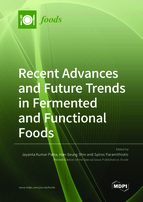Recent Advances and Future Trends in Fermented and Functional Foods
A special issue of Foods (ISSN 2304-8158). This special issue belongs to the section "Food Nutrition".
Deadline for manuscript submissions: closed (27 February 2022) | Viewed by 42423
Special Issue Editors
Interests: antioxidant activity; bioactive compounds; medicinal plants; functional foods; biomolecules; nanobiotechnology
Special Issues, Collections and Topics in MDPI journals
Interests: functional foods
Interests: food microbiology; food biotechnology; molecular microbiology
Special Issues, Collections and Topics in MDPI journals
Special Issue Information
Dear Colleagues,
Health and wellness are among the core segments of quickly-changing consumer goods, with ever-increasing health consciousness among consumers around the globe. Functional foods and beverages, formulated from natural ingredients with targeted physiological functions, are at the heart of research and development in the food industry. The application of modern biotechnology methods in the food and agricultural industry is expected to alleviate hunger today and help avoid mass starvation in the future. Modern food biotechnology has in recent years been transforming existing methods of food production and preparation far beyond the traditional scope. Currently, at the global level, food biotechnological research has focused on traditional process optimization (starter culture development, enzymology, fermentation), food safety and quality, nutritional quality improvement, functional foods, and food preservation (improving shelf life). The fermentation of substrates considered for human consumption has been applied for centuries as a process that enhances shelf life, sensory properties, and nutritional value. Special emphasis has also been given to newly growing concepts, such as functional foods and probiotics. The application of biotechnology in the food sciences has led to an increase in food production and has enhanced the quality and safety of food.
This Special Issue will provide a platform for generating data on more recent information and research available in this sphere throughout the world in the form of valuable research articles, reviews, and mini reviews on various aspects related to future prospects in fermented and medicinal foods.
Dr. Jayanta Kumar Patra
Prof. Han-Seung Shin
Dr. Spiros Paramithiotis
Guest Editors
Manuscript Submission Information
Manuscripts should be submitted online at www.mdpi.com by registering and logging in to this website. Once you are registered, click here to go to the submission form. Manuscripts can be submitted until the deadline. All submissions that pass pre-check are peer-reviewed. Accepted papers will be published continuously in the journal (as soon as accepted) and will be listed together on the special issue website. Research articles, review articles as well as short communications are invited. For planned papers, a title and short abstract (about 100 words) can be sent to the Editorial Office for announcement on this website.
Submitted manuscripts should not have been published previously, nor be under consideration for publication elsewhere (except conference proceedings papers). All manuscripts are thoroughly refereed through a single-blind peer-review process. A guide for authors and other relevant information for submission of manuscripts is available on the Instructions for Authors page. Foods is an international peer-reviewed open access semimonthly journal published by MDPI.
Please visit the Instructions for Authors page before submitting a manuscript. The Article Processing Charge (APC) for publication in this open access journal is 2900 CHF (Swiss Francs). Submitted papers should be well formatted and use good English. Authors may use MDPI's English editing service prior to publication or during author revisions.
Keywords
- functional food and nutraceuticals
- fermentation technology
- industrial scale fermentation
- applications of enzymes in food processing
- evolving techniques in food processing
- food and bioactive compounds
- genetically modified organisms in food
- food safety and quality
- nutritional quality improvement
- food preservation









